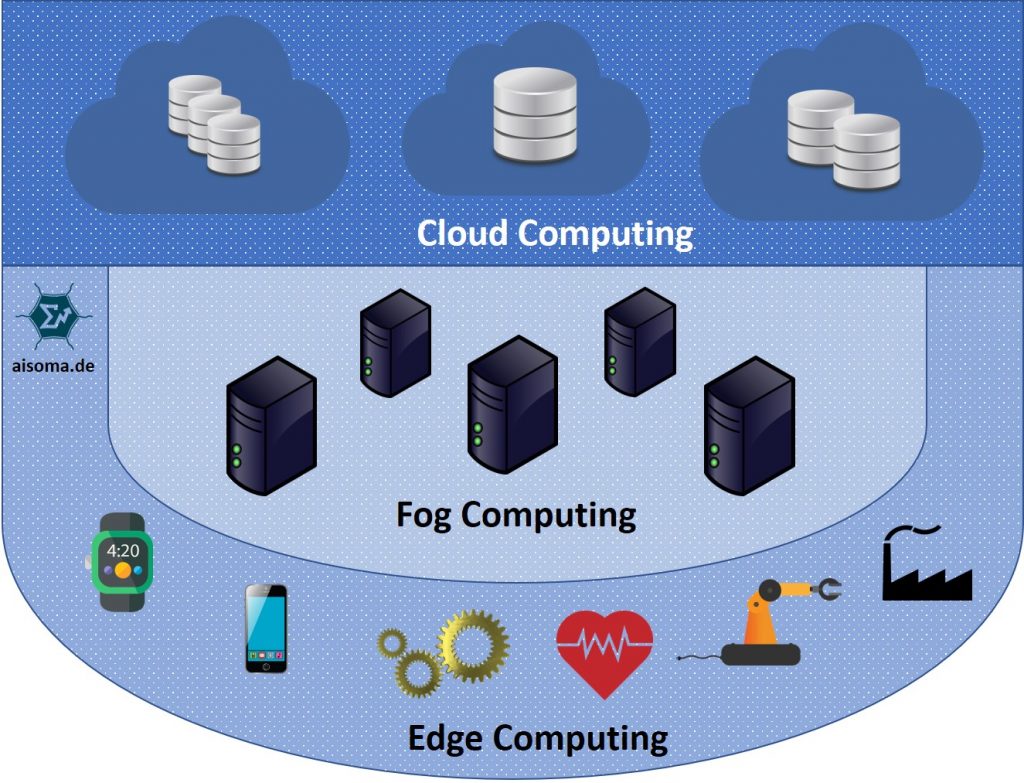In contrast to cloud computing, edge computing refers to decentralized data processing at the edge of the network.
Edge Computing
Edge computing involves moving computer applications, data, and services from central nodes (data centers) to the outer edges of a network. In other words, the aim is to process data streams on the spot at least partially (e.g., directly at the end device or within a factory) in a resource-saving manner while still benefiting from the advantages of the cloud. This approach requires the use of resources that are not permanently connected to a network, such as controllers, notebooks, smartphones, tablets, and sensors. Edge computing includes numerous technologies such as sensor networks, mobile data capture, mobile signature analysis, peer-to-peer and ad hoc networking. Edge computing can be used as an architectural concept for the Internet of Things (IoT), which links uniquely identifiable physical objects (things) with a virtual representation in an Internet-like structure. Instead of Edge Computing, the terms Fog Computing, Local Cloud or Cloudlet are occasionally used. With Fog Computing, however, the focus is less on the end devices, but rather on bringing the cloud resources closer to the applications (decentralization).

Advantages and Disadvantages
The Edge App’s services significantly reduce the volume of data to be transmitted, thereby reducing data exchange and transmission distance, reducing transmission costs and waiting times, and improving overall service quality. Edge computing reduces or eliminates the need for central data centers, eliminating a bottleneck for data transfer and a potential source of error. Security also improves as encrypted files are processed closer to the network core. When the data reaches the enterprise, viruses, corrupted data, and hacker attacks can be intercepted early. Ultimately, the ability to virtualize extends scalability, meaning that the number of edge devices on the network can be quickly increased. Edge computing better supports real-time requirements on the Internet of Things than cloud computing, whereas edge computing has its drawbacks when processing or storing a massive amount of data or when computing or storage requirements are very irregular.
Frequently Used Terms
Edge Devices: These can be any device that produces data. These could be sensors, industrial machines or other devices that produce or collect data.
Edge: What the edge depends on the use case. In a telecommunications field, perhaps the edge is a cell phone or maybe it’s a cell tower. In an automotive scenario, the edge of the network could be a car. In manufacturing, it could be a machine on a shop floor; in enterprise IT, the edge could be a laptop.
Edge Gateway: A gateway is a buffer between where edge computing processing is done and the broader fog network. The gateway is the window into the larger environment beyond the edge of the network.
Fat Client: Software that can do some data processing in edge devices. This is opposed to a thin client, which would merely transfer data.
Edge Computing Equipment: Edge computing uses a range of existing and new equipment. Many devices, sensors, and machines can be outfitted to work in an edge computing environment by simply making them Internet-accessible. Cisco and other hardware vendors have a line of ruggedized network equipment that has hardened exteriors meant to be used in field environments. A range of computer servers converged systems and even storage-based hardware systems like Amazon Web Service’s Snowball can be used in edge computing deployments.
Mobile Edge Computing: This refers to the buildout of edge computing systems in telecommunications systems, particularly 5G scenarios
For more Terms look at The Linux Foundation’s Open Glossary of Edge Computing
Outlook
Edge computing plays a significant role in networking production equipment in industry 4.0 with information and communication technology. In this context, the expansion of the conventional programmable logic controller (PLC) to an edge controller is also to be seen.
[bctt tweet=”What is Edge Computing? A Brief Introduction. #EdgeComputing #IoT #IIoT #Industry40 #MachineLearning #AI #DataAnalytics #Serverless” username=”AISOMA_AG”]
If you have any questions, please do not hesitate to contact us.
AISOMA
Further readings: